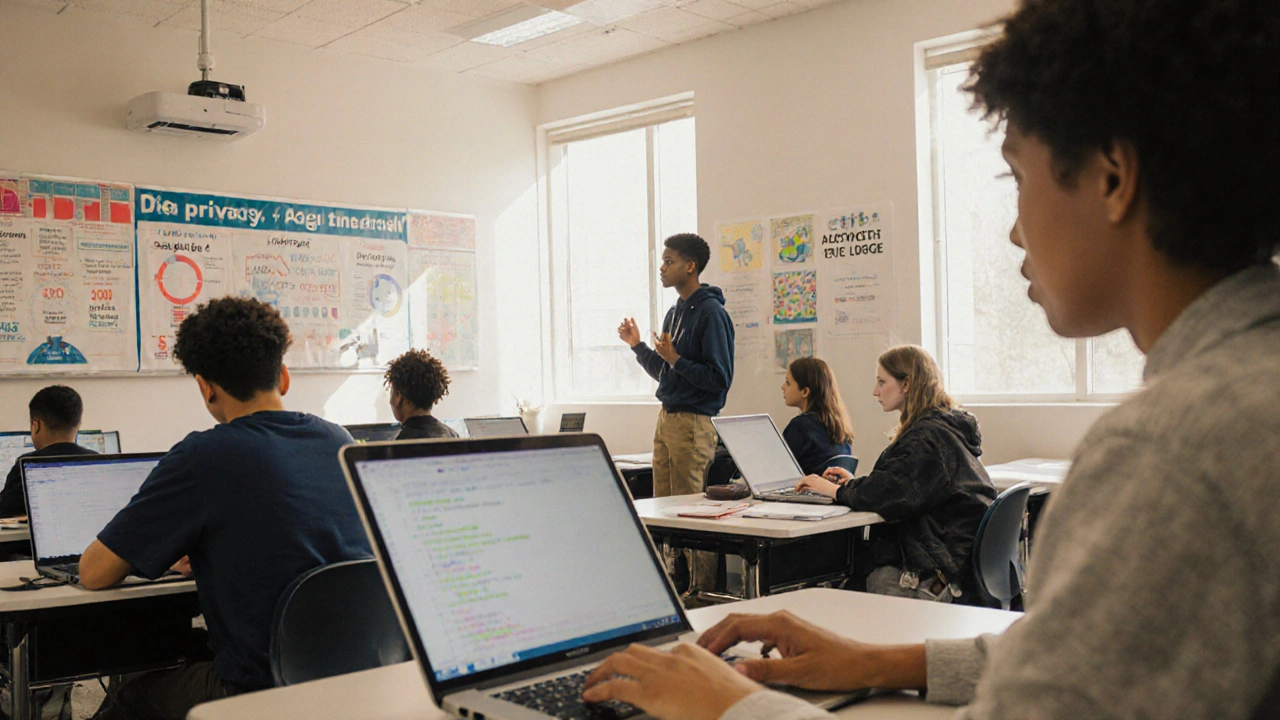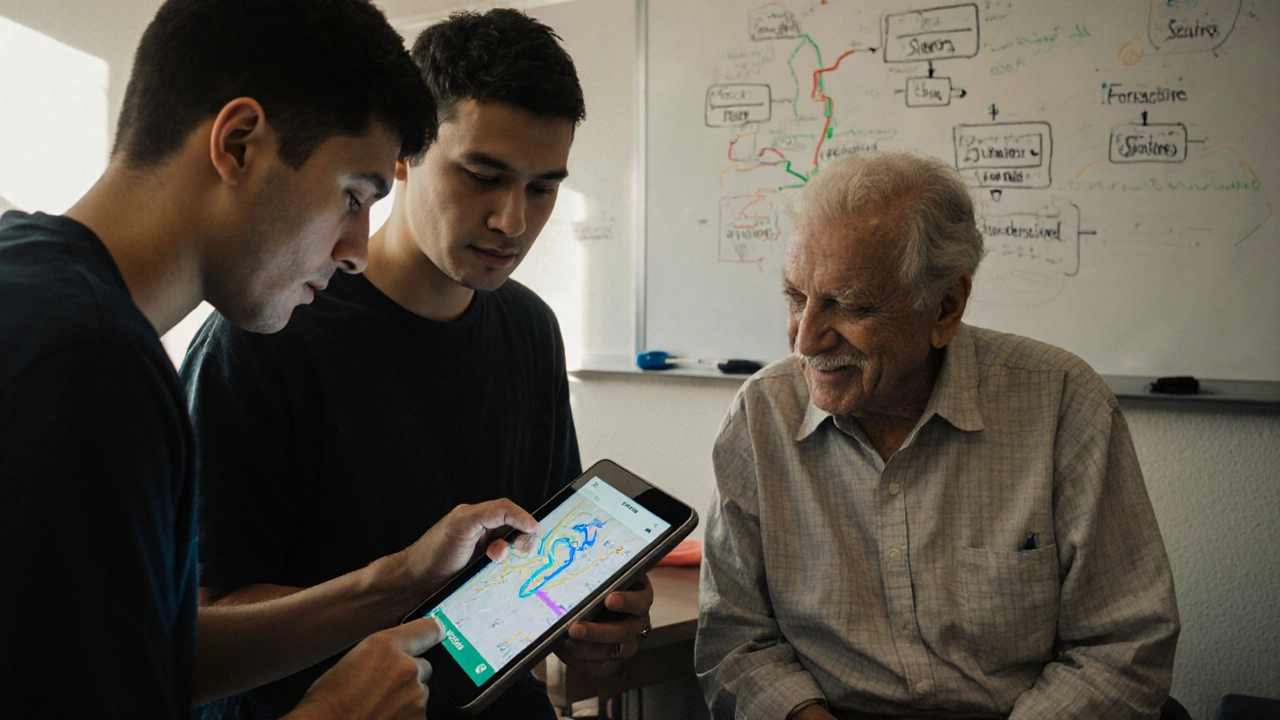High Schools Preparing Students for a Digital Future

By 2030, nearly 80% of jobs will require some level of digital proficiency. That’s not a guess-it’s what the World Economic Forum projects. Yet many high schools are still teaching typing and basic spreadsheet use like it’s 2005. If your child’s school hasn’t moved past PowerPoint presentations and Google Docs, they’re falling behind. The digital future isn’t coming-it’s already here, and high schools need to catch up.
What Does ‘Digital Future’ Actually Mean for Students?
It’s not just about using laptops or watching videos online. The digital future means understanding how algorithms shape what they see, how data is collected and used, and how to build simple tools-not just consume them. A student who can code a basic app to track their homework, analyze social media trends for a history project, or use AI to draft and refine an essay isn’t just tech-savvy. They’re future-proofed.
Look at what’s already in classrooms: AI writing assistants like Grammarly and ChatGPT are used by 62% of U.S. high schoolers, according to a 2024 Pew Research study. But only 18% of schools have formal lessons on how to use them ethically or effectively. That’s like giving kids a car and saying, ‘Don’t crash,’ without teaching them how to drive.
Skills That Matter More Than Ever
Forget memorizing formulas or historical dates. The real skills students need are:
- Digital literacy: Not just knowing how to use apps, but understanding privacy settings, spotting deepfakes, and evaluating online sources.
- Computational thinking: Breaking problems into steps, recognizing patterns, and designing solutions-whether they’re coding or organizing a school fundraiser.
- Collaboration in digital spaces: Using shared documents, project tools like Trello or Notion, and video conferencing with clarity and professionalism.
- Basic coding and automation: Even if they don’t become engineers, knowing how to write a simple script to auto-fill forms or sort data saves hours every week.
- AI fluency: Knowing when to ask AI for help, how to check its answers, and how to prompt it well.
These aren’t electives. They’re survival skills. A student who can automate a repetitive task with a few lines of Python will have an edge in college, internships, and entry-level jobs-even in fields like nursing or journalism.
What High Schools Are Doing Right
Some schools are already ahead. In Chicago Public Schools, over 40 high schools now offer a required one-semester course called Digital Foundations. It covers data privacy, basic Python, and using AI tools responsibly. Students build a personal digital portfolio-no more just a resume. They show projects, code snippets, and reflections on how they used tech to solve real problems.
In Austin, Texas, a public high school partnered with a local tech nonprofit to let students build apps for city services. One group created a tool that helps seniors find accessible bus routes. Another built a chatbot that answers common questions about college applications. These aren’t gimmicks. They’re real work with real impact.
And it’s working. Graduates from these programs are 3x more likely to pursue STEM-related college majors and 50% more likely to land internships before graduation, according to a 2025 study by the National Center for Education Statistics.

Where Schools Are Still Falling Short
Most high schools still treat tech as an add-on. Computer science is often a single elective, offered only if there’s a teacher who knows how to teach it. Many districts haven’t updated their curriculum since the iPad was new. Teachers are expected to teach digital skills without training, resources, or time.
There’s also a dangerous gap in access. A 2024 survey by EdWeek found that 37% of low-income high schools don’t have a single full-time tech teacher. Meanwhile, wealthier districts have robotics labs, 3D printers, and AI tutors. That’s not equity. That’s a digital divide-and it’s widening.
And let’s talk about assessment. Students are still graded on handwritten essays and multiple-choice tests. But in the real world, work is collaborative, digital, and iterative. Why are we testing them like it’s 1998?
What Parents and Students Can Do Now
You don’t have to wait for the school system to fix itself. Here’s what you can do today:
- Ask your school: Does the curriculum include digital literacy and AI use? Is there a plan to teach coding beyond Scratch? If not, push for it.
- Use free tools: Code.org, Khan Academy’s computer science courses, and Google’s CS First program are all free and designed for teens.
- Encourage projects: Help your child build something-maybe a website for their club, a spreadsheet to track their savings, or a simple app to remind them to do chores.
- Teach critical thinking: When they use ChatGPT, ask: ‘How did you check that answer?’ ‘What’s the source?’ ‘What might it have missed?’
- Look beyond grades: A student who built a TikTok-style video explaining climate change using data visualization has more real-world skills than one who got an A on a textbook quiz.

It’s Not About Replacing Teachers-It’s About Empowering Them
Some people think tech will replace teachers. It won’t. But it will change what teaching looks like. The best teachers now aren’t the ones who lecture the most. They’re the ones who guide students to solve problems using digital tools. They’re the ones who say, ‘Here’s a problem. Go figure it out-with your laptop, your phone, and your brain.’
That shift takes support. Schools need professional development, updated devices, and time to redesign lessons. But more than anything, they need permission to change. Too many districts are stuck in a ‘if it ain’t broke’ mindset. But if your kid’s future job doesn’t exist yet, how can you teach it the old way?
The Bottom Line
Preparing students for a digital future isn’t about buying more tablets or installing fancy software. It’s about changing how we think about learning. It’s about trusting students to create, not just consume. It’s about giving them the tools to solve problems we haven’t even named yet.
If your child’s high school isn’t teaching them how to think with technology-not just use it-they’re not preparing them for the world they’ll inherit. The future isn’t waiting. It’s already in the classroom. The question is: are we ready to meet it?
What digital skills should high school students learn by graduation?
By graduation, students should be able to use AI tools responsibly, write basic code to automate tasks, evaluate online information for bias and accuracy, collaborate using digital platforms like Google Workspace or Notion, and create digital portfolios that showcase their work. These skills go beyond using Word or Excel-they’re about understanding how technology shapes communication, work, and society.
Is coding necessary for every student, even if they’re not going into tech?
Yes. You don’t need to become a software engineer to benefit from coding. Learning to code teaches problem-solving, logic, and persistence. A student who can write a script to sort data for a biology project, automate a budget spreadsheet for a business class, or build a simple website for a school club gains an edge in any field. Coding is becoming like writing or math-it’s a fundamental skill.
How can parents tell if their child’s school is truly preparing students for a digital future?
Look for projects that require students to build, not just answer. Ask if students create digital portfolios, use AI tools in class with guidance, or solve real-world problems using technology. Check if computer science is required, not optional. And see if teachers are trained-not just given devices, but taught how to integrate tech into lessons meaningfully. If the school still uses paper quizzes and no digital collaboration tools, they’re behind.
Are free online resources enough to replace school programs?
Free resources like Code.org or Khan Academy are excellent supplements, but they can’t replace a structured school curriculum. Not every student has access to a quiet space, a reliable device, or a parent who can guide them. Schools are the only place where every student, regardless of background, can get equal exposure to digital skills. Relying on home learning deepens inequality. Schools need to step up.
What’s the biggest mistake schools make when trying to go digital?
The biggest mistake is thinking tech = progress. Buying Chromebooks or installing learning apps doesn’t change learning if the teaching doesn’t change. Many schools just replace paper worksheets with digital ones. True digital readiness means letting students create, experiment, fail, and rebuild-using tech as a tool, not a crutch. It’s about mindset, not gadgets.